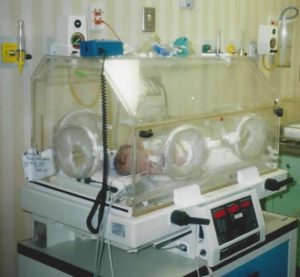Spring Issue Articles
 In Spring Issue 2019
In Spring Issue 2019
Written by Mia Kalef, DC Reviewed by Nancy Eichhorn, PhD
Watching my 17-year-old nephew the other day fascinated me. He was rolled up in a fleece blanket like a ‘hot dog in a bun’. The two-toned colored blanket is well-known to my nephew and his twin sister. It’s a throw of sorts that lives on our couch in Sun Valley, Idaho, where my parents have shared time and love with their grandchildren since their birth.
On this afternoon, my nephew was asking his dad to bundle him, to secure the edges of the blanket so he was tightly swaddled, then he wanted a pillow for his head. Normally this wouldn’t have caught my attention in any particular way, he’s always been a snuggler, even wears “onesies”, adult sized of course, and loves the sensation of being surrounded, contained by warmth.
Why the difference in focus on my part?
Mia Kalef.
I’d been reading her book, It’s Never Too Late: Healing Prebirth and Birth at Any Age, and I realized that my nephew might be replaying a birth/afterbirth experience. In short, nothing birth-wise went as planned (their conception and pregnancy have their own stories that I am sure have an impact as well). Staying focused here, however, their birth was supposed to be natural, no drugs, lots of time and space, babies placed on my sister’s belly to complete the birthing process. All the “right” stuff had been discussed and supposedly in place.
 It didn’t go that way.
It didn’t go that way.
The basic facts are: the twins were not ready or awake even when the doctor surgically opened the womb via Cesarean section; my nephew was jaundiced and taken away; my niece was startled awake and taken by a nurse for typical hospital procedures; my sister was foggy under the influence of heavy medication and feeling the pain from the invasive surgery. It was not as predicted or wanted.
Mia had me thinking more in-depth about conversations we’ve had in our family surrounding the twins’ conception story, their pregnancy story, their birth and after birth story. I totally accept and believe that our womb experiences as well as our birth and after birth experiences manifest throughout our lives. I was taken by Mia’s presentation of both information about what happens and what outcomes may result and also her specific processes, complete with dialogues and case studies, to work toward understanding and healing moments that can and do create imprints that influence our lives to come—who we are in this world, how we view ourselves within our family system as well as our communities at large, and how we believe the world accepts and values us.
In his forward to Mia’s book, Jaap van der Wal, an embryologist, phenomenologist and philosopher from Maastrict, The Netherlands, shared that he was “very impressed how Mia really helps us to communicate with the (wounded) soul of the infant, the not yet verbally equipped child: in order to exchange with each other and to help find our way back to the experiences, and maybe wounds, that are still there in the unconscious domain of the body and in order to help the child to cope with and find a new balance in the sometimes disturbed equilibrium of the soul” (Kalef, 2018, pg. iii).
I appreciated Mia’s focus on connecting with our prenatal consciousness and awareness and then teaching us how to tune into the language and behaviors that we, as adults, infants, fetuses, and even embryos use to express our feelings, our aspirations and hopes, our fears and disappointments and our traumas.
The book is divided into two parts. Part 1: Preparing for our work, includes: Chapter 1: Perspectives, Chapter 2: The Family Field, Chapter 3: How to Communicate. Part 2 provides in- depth work with The Imprints including: Chapter 4: Pre- Birth Imprints, Chapter 5: Birth Imprints, and Chapter 6: When babies don’t survive. From start to end there’s only 145 pages; it’s an easy read—the material is presented clearly, concisely. There’s a logical sequencing from start (pre-conception) to finish (be it “the fourth stage of labor”, separation, or loss via miscarriage or twin loss). Case studies support all aspects discussed in the book, providing concrete interactions—you are invited into therapy sessions to see this work in action.
In this review, I offer a few thoughts that resonated with me and invite you to read the book if anything I’ve written, or you’ve read in Mia’s reflection on page 12 spark an interest.
 The Conception Field
The Conception Field
I was taught that the sperm makes it way, tail wagging like a pollywog, swimming toward its target—the egg. I learned that the sperm penetrates the egg, almost forcefully it seemed to me, and that it fights with other sperm to be the one and only to gain entrance and fertilize the egg thus creating a human being. I much prefer Mia’s presentation of Dr. van der Wal’s Preconception Attraction Complex (PCAC). Per Mia, we are invited to envision a mystical dance rather than a hostile take over and penetration. From this perspective, the sperm and egg are courting; their ‘spinning’ behaviors result in a transmutation where each loses their former self to create a new relationship (Kalef, 2018, pg. 42-43).
Conception Imprints
When I learned I was pregnant the first time, I panicked. I was not married, albeit engaged, and the relationship was not, well, we had issues. I considered options but in the end my fiancé and I opted to move forward as soon-to-be married parents. I always wondered if my fear and immediate rejection of this being was part of the miscarriage, if this little soul felt the time was wrong for her to join this world. While I’ll never “know”, I do believe that the parents’’ reactions to learning they are pregnant whether trying (i.e. timing ovulation for lovemaking) or it happened “accidentally” or “unconsciously”, impact this new soul.
married parents. I always wondered if my fear and immediate rejection of this being was part of the miscarriage, if this little soul felt the time was wrong for her to join this world. While I’ll never “know”, I do believe that the parents’’ reactions to learning they are pregnant whether trying (i.e. timing ovulation for lovemaking) or it happened “accidentally” or “unconsciously”, impact this new soul.
Mia writes about these pre-birth imprints including conception, implantation, assisted reproduction, unwanted children, the discovery phase, and more. She offers scenarios of what conception imprints may look like behaviorally in infants, children and adults. She then shares ways to heal these imprints. She offers exercises to connect with and forge a relationship with your body, to imagine your body’s intelligence and explore what might have happened during this time.
Moving into birth imprints, Mia offers extensive exercises to address the birth experience for mothers, infants, toddlers, and adults as well as sharing an excerpt from Robert Oliver’s article, The Ideal Cesarean Birth (Kalef, 2018, pg. 104). There’s information on induced labor, the use of forceps and vacuums, effects of separation, neonatal intensive care and surgery.
After reading Mia’s book, I wanted to give copies to several friends who are experiencing situations within themselves and with their children (young and old alike). It’s user-friendly so I have a sense that even those who are not necessarily in sync with my line of thought will resonate with the information and perhaps see a little of their own lives in the overviews of what can happen (behavioral insights) and in the case studies (a deeper look in action). It will be interesting to see how and if they react.
Nancy Eichhorn is the Founding Editor-in-Chief of Somatic Psychotherapy Today. She works as a freelance writer, editor and teacher. Her writing resume includes over 5,000 newspaper and magazine articles, and chapters in professional anthologies, including, When Hurt Remains: Relational Perspectives on Therapeutic Failure, About Relational Body Psychotherapy, and The Body in Relationship; Self-Other-Society. She is an avid hiker, cyclist, kayaker/paddle boarder, backpacker. Like a blank page, nature’s innocence offers her solace and the space for inner expression in a physically outward way.







